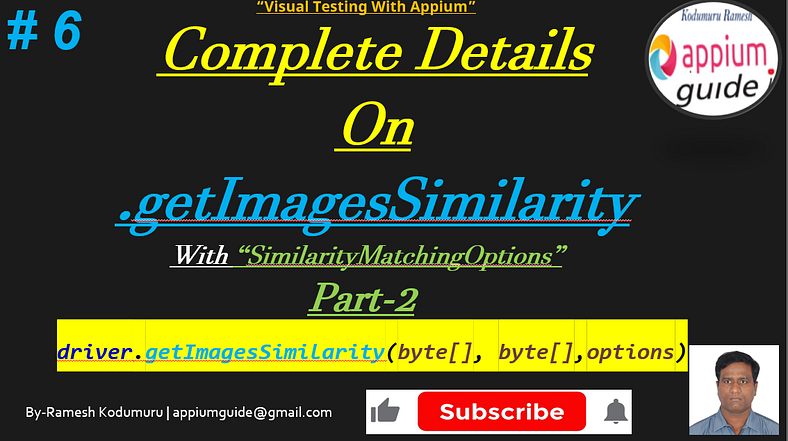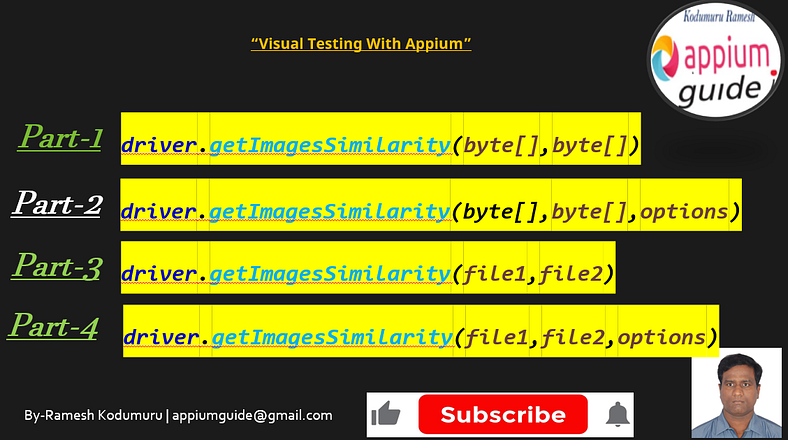Appium Visual Testing -6(Part-2) : Complete Details On Built-In method —” .getImagesSimilarity” with ‘SimilarityMatchingOptions’
.getImagesSimilarity(byte[] base64image1, byte[] base64image2, SimilarityMatchingOptions options)

Watch the video below for your complete step-by-step guide!
In this article, the second in a four-part series, will explore one of Appium’s built-in methods
.getImagesSimilarity(byte[] base64image1, byte[] base64image2, SimilarityMatchingOptions options)

Deep Dive into "
.getImagesSimilarity(byte[ ] base64image1, byte[ ] base64image2, SimilarityMatchingOptions options)"
Introduction
In modern test automation, visual validation is gaining prominence due to the need for pixel-perfect UI verification across different platforms and devices. Tools like Appium support image-based comparison to ensure UI integrity, particularly when DOM-based assertions aren’t sufficient. One such powerful method is:
driver.getImagesSimilarity(byte[] base64image1, byte[] base64image2, SimilarityMatchingOptions options)This method enables flexible and configurable image comparison by leveraging an additional SimilarityMatchingOptions parameter to fine-tune the matching behavior.
Method Signature Overview
Syntax
SimilarityMatchingResult result = driver.getImagesSimilarity(
byte[] base64image1,
byte[] base64image2,
SimilarityMatchingOptions options
);Parameters
ParameterTypeDescriptionbase64image1byte[]First image in Base64-encoded byte array form.base64image2byte[]Second image to compare.optionsSimilarityMatchingOptionsObject to specify tolerance, match threshold, and more.
Returns
SimilarityMatchingResult: Contains detailed results of the image comparison including:- score: Similarity value (typically between 0.0 and 1.0).
- rectangles: Areas where mismatches were found.
- visualization: Optional diff image for debugging.
- status: Match pass/fail based on the defined threshold.
Step-by-step demonstration of how to use the method
.getImagesSimilarity(byte[ ] base64image1, byte[ ] base64image2, SimilarityMatchingOptions options)
Step 1: Capture the Screenshot
Step 2: Covert the file to base64image
Step 3: Create Similarity Options
Step 4: Perform the Comparison
Step 5: Print the Result
Step 6: Visualize the difference
Step 7: Run Appium Server with below flags:
The plugin must be explicitly activated when launching the Appium server:
appium - use-plugins=images“Complete Code: Optimized and Ready to Use”:
package com.appiumguide.appiumvisualTesting;
import org.apache.commons.io.FileUtils;
import org.openqa.selenium.OutputType;
import org.testng.annotations.AfterTest;
import org.testng.annotations.BeforeTest;
import org.testng.annotations.Test;
import io.appium.java_client.android.AndroidDriver;
import io.appium.java_client.android.options.UiAutomator2Options;
import io.appium.java_client.imagecomparison.SimilarityMatchingOptions;
import io.appium.java_client.imagecomparison.SimilarityMatchingResult;
import java.io.File;
import java.io.IOException;
import java.net.*;
import java.nio.file.Files;
import java.time.Duration;
import java.util.Base64;
/**
* Script Details - Appium-Visual Testing (Part-2): Complete Details On .getImagesSimilarity(byte[] base64image1, byte[] base64Image2,SimilarityMatchingOptions options)
*
* appium-java-client version: Latest
*
* @author 'Ramesh Kodumuru' for AppiumGuide [appiumguide@gmail.com]
*/
public class GetImagesSimilarity_Demo2 {
private AndroidDriver driver;
File screenshot;
@BeforeTest
public void setup() throws MalformedURLException {
UiAutomator2Options cap=new UiAutomator2Options();
cap.setPlatformName("android");
cap.setAutomationName("uiautomator2");
cap.setDeviceName("Pixel9");
driver = new AndroidDriver(new URL("http://127.0.0.1:4723"), cap);
driver.manage().timeouts().implicitlyWait(Duration.ofSeconds(100));
}
@Test
public void test() throws InterruptedException, IOException {
//Launch thw wdiodemo app
driver.activateApp("com.wdiodemoapp");
Thread.sleep(5000);
//Step 1: Capture the Screenshot
System.out.println("Step 1: Capture the Screenshot");
FileUtils.copyFile(driver.getScreenshotAs(OutputType.FILE), new File("actual_image"+".png"));
Thread.sleep(5000);
//Step 2: Convert the file to base64image
System.out.println("Step 2: Convert the file to base64image");
byte[] img1Bytes=Files.readAllBytes(new File(System.getProperty("user.dir")+"/actual_image.png").toPath());
byte[] img2Bytes=Files.readAllBytes(new File(System.getProperty("user.dir")+"/Expected_image.png").toPath());
byte[] base64Image1=Base64.getEncoder().encode(img1Bytes);
byte[] base64Image2=Base64.getEncoder().encode(img2Bytes);
//Step 3: Create SimilarityMatchingOptions
System.out.println("Step 3: Create SimilarityMatchingOptions");
SimilarityMatchingOptions options=new SimilarityMatchingOptions().withEnabledVisualization();
//Step 4: Perform the Comparison
System.out.println("Step 4: Perform the Comparison");
SimilarityMatchingResult result=driver.getImagesSimilarity(base64Image1, base64Image2, options);
Thread.sleep(5000);
//Step 5: Print the Result
System.out.println("Step 5: Print the Result");
System.out.println("Similarity Score - : "+result.getScore());
//Step 6: Visualize the difference
System.out.println("Step 6: Visualize the difference");
if(result.getVisualization()!=null) {
byte[] vis=Base64.getDecoder().decode(result.getVisualization());
Files.write(new File("visual_diff.png").toPath(),vis);
}
}
@AfterTest
public void teardown() {
if(driver!=null) {
driver.quit();
System.out.println("Test Completed");
}
}
}
Best Practices
- Normalize resolution before comparison.
- Use ROI and ignored regions to reduce false negatives.
- Set a realistic threshold based on your UI consistency expectations.
- Enable visual diff during debugging.
Conclusion
The driver.getImagesSimilarity(byte[] base64image1, byte[] base64image2, SimilarityMatchingOptions options) method is a robust feature for visual validation in test automation frameworks. It allows you to go beyond simple image comparison, giving you control over accuracy, tolerance, and analysis depth. This makes it a vital tool for maintaining visual quality across test runs.
GitHub Link:
🎬 Explore More! Watch My Latest Videos on YouTube!

No comments:
Post a Comment